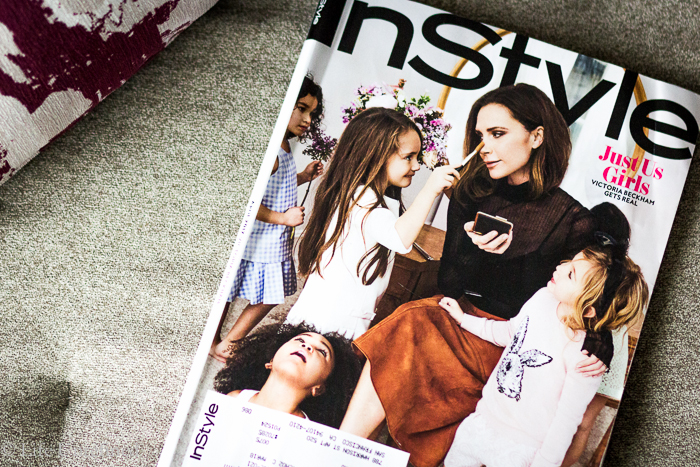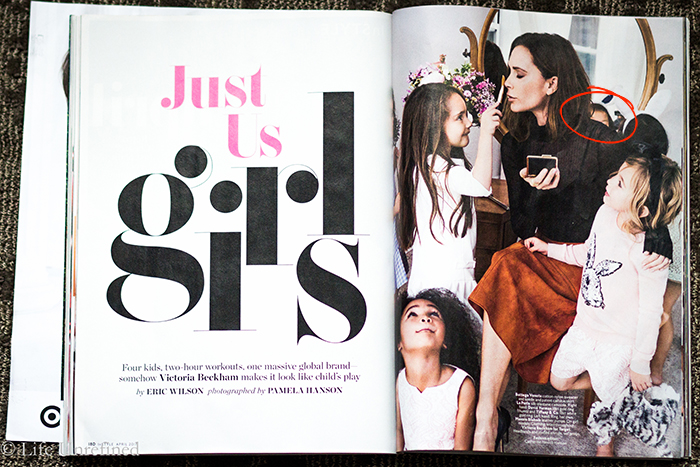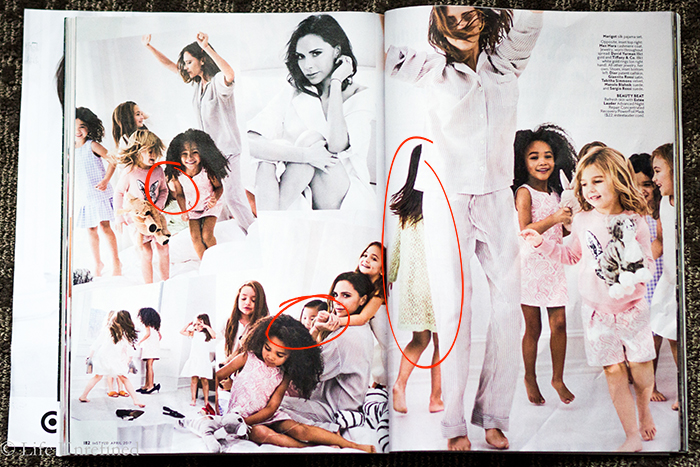 I always look forward to the latest issue of InStyle arriving in the mail, and this month was no different. As a new mom, I thought it was sweet that a circle of little girls graced the cover with the elegant Victoria Beckham. Her collaboration with Target will be launching in a couple of weeks, so I eagerly turned to page 180 in anticipation of learning more.
I always look forward to the latest issue of InStyle arriving in the mail, and this month was no different. As a new mom, I thought it was sweet that a circle of little girls graced the cover with the elegant Victoria Beckham. Her collaboration with Target will be launching in a couple of weeks, so I eagerly turned to page 180 in anticipation of learning more.
As I looked through the photo spread and studied the girls’ clothing (mentally listing the ones I wanted to buy for Little V), I suddenly noticed part of a little Asian girl’s face on the bottom right side of page 182. Oh that’s nice they’re being inclusive, I thought, until I looked for her in other photos of the spread. In one photo (page 181) you could see the girl’s right eyebrow and forehead. In another you see her right cheek (page 182). Yet another had part of her back, hair, and legs (page 183). Except for the first shot I noticed, she was practically invisible. If you had photoshopped a blank space over her in all those pictures, it would hardly make a difference. Her presence didn’t matter.
What happened next took me by surprise. I felt outraged. I felt hurt. I felt shamed. I was in disbelief. It was a magazine photo shoot, but it felt personal. While it may have been unintentional on the photographer’s part, these pictures perpetuated the stereotype I had often felt growing up – be quiet, stay in the back, don’t let anyone notice you. While all the other girls had at least one shot where they were clearly front and center, this little Asian girl was always in the back, or not in the picture at all.
Why? And who is responsible? Should it be the photographer’s responsibility to be more inclusive? Should he have coaxed the little girl into letting her shine? Should it have been the editorial staff to make sure there was at least one photo where she was fully represented? Even if you make the argument that this little girl was shy, then shouldn’t they have made a better effort in finding a more rambunctious Asian girl model?
Because not all Asians are meek and reserved. Not all of us stand in the background, content with whatever is given to us.
I resented it then, but appreciate now how my Dad used to push me in the front whenever we were in a large group of any kind, whether it be a museum or visiting some tourist site in a foreign country. “Ask questions,” he insisted, “get their attention.” I retorted that he should ask the questions himself, not understanding he could see into my future. That if I didn’t speak up, I would disappear and nobody would notice. We are a race that has quietly excelled in many areas, but when it comes to media and the public spotlight, we are underrepresented. The first and last time an “Asian” was nominated for Best Actress was in 1935. And Merle Oberon clearly looked more white than Indian.
And yet, while we can (and should) hold photographers and national magazines responsible for their ignorance, I realize that I, too, am also partly to blame. I think back to the many times I was mocked and humiliated as a kid and an adult, and how I just stood there, saying nothing. How can I let my own daughter know that she deserves just as much “face time” as any other girl regardless of race or ethnicity, that she is just as beautiful and worthy, if I don’t start by standing up for myself?
We have a voice. Let’s use it.


Hi Jen, I am sorry that you had to experience this, not for the first or probably the last time. It does sound hurtful. Even if it was inadvertent or subconscious on the part of the creators, enough of these subconscious “errors” or experiences together add up to a pattern that affects everyone’s subconscious views. Media depictions really shape how we type ourselves and “others.”
I always wonder how Jesus would respond to the manifestations of racism in our world today. Would he be a social justice warrior marching in the streets? Would he simply sit with those who are hurting? Would he have dinner with the editors of the magazine and then forgive their sins? Would he call out society as a whole for its marginalization of so many people? It’s hard to say, but maybe a little “yes” on many different fronts. On the one hand, he clearly expressed God’s closeness to those who are hurting or marginalized, even calling them blessed (and he should know, since in the end he experienced total abandonment himself), and yet, rather than asserting his own rights, he sacrificed them for our (undeserving) sake, and this is a hard model that he asks us to follow. What to make of this Jesus in the world we now live?
I think as a believer, I always have to first take the plank out of my own eye and fight against the tendencies to stereotype, to ignore, to shift blame, to fear, even to hate that are buried in my own heart. Ultimately, I think the propensity to really see and hear those who are “like us,” to champion what benefits our own “in group,” to notice oppression when we feel it and ignore it when someone else feels it or when we are causing it, are such an ingrained messed up part of what it means to be humans with sinful natures. So much of human history suggests to me that we are wired to identify with our in-group and try to triumph over the out-group, either by force or ignoring their plight. Such a deep sin problem has only one answer for healing and redemption – Jesus. I absolutely believe it is my job to continue wrestling (with the help of the Holy Spirit) with issues of race and sex and class and ability and gender and so forth and to act on what I learn – to advocate for little Asian girls to be front and center in magazines. Yet I am ultimately thankful God is a God of justice who says it is in his job description to be in charge of making the last first and the first last. In the end, He WILL make it right, and that is one huge promise.
After typing this all out, I realize I got a little side-tracked there with my wondering about Jesus when I really just want to come back to saying, once again, that I’m sorry this happened to you. I will keep reading and listening and learning from you, my dear amazing friend. Love you!
You know, if it was just the cover (where Asian girl’s head is easily mistaken for furniture) I wouldn’t even notice. But the pages in the editorial, where blurry, blocked shards of the Asian girl are showing in between the cracks of other people, it’s like whoa…. the image is painful for me too. But I agree with Kristen.. for a holy anger that submits to Christ. I do find immense comfort in is that Christ loves the outcast and invisible specifically. I know God takes joy and delight in bringing the high low, and the low high, flattening mountains and raising valleys. I think your voice can add to the necessary chorus of those crying out for justice in a way that invites oppressors to repentance in gentleness, grace, and humility.
This is a great post. I also feel outraged about the underrepresentation of Asian women in media. There’s so much talk about black women at the Oscars but not Asian or Native American women. Some things that have made me happy are shows with prominent Asian women, and Old Navy has been sending me ads featuring a mixed race white/Asian family.
I hear ya. It is frustrating that the little Asian girl is largely absent and hidden. It is good that you identified her and brought attention to her though. She deserves that much! She needs people like you. I agree that Asians are not always represented in media. It’s hard to not see yourself in media as important or beautiful, etc.
Growing up, I experienced the model minority stereotype. I was one of a handful of Asian kids amongst mostly white kids. Though I am white and Chinese, I identified more with my ,Chinese ethnicity partly because my peers saw me as different and as the ‘Asian’ one. Race was such a big thing for me that I went on to major in ethnic studies. I would cry after class at times because I had finally learned the Asian American history and it hurt, but it also helped me understand where the biases/stereotypes originated. I recount all that just to say that I’ve felt that frustration and hurt around the under representation and stereotypes too. I feel proud of you as a friend for bringing it up and noticing as well.
Interesting that you brought up Merle Oberon. I looked her up, she was ,,Anglo-Indian, but she hid the fact that she was Indian so she could ‘pass’ as white and be accepted into the Hollywood scene. For me, your phrase, ‘she clearly looks more white than Asian’ hits a sore spot because it’s similar to what I hear from many people about how I look. I understand that it’s because her features might be what we typically think of as white and that is how she could pass into Hollywood, but some might see her as more Indian. Who is to say what Indian or white exactly looks like anyways? I usually cring when people say something like that to me because I figure I just AM Chinese and just AM white, regardless of looks or what a person thinks of as Chinese looking or white looking. The phrase all at once keeps me from being part of either ‘group’, making a line of what is and isn’t a certain look for a race/ethnicity. But, i also understand where they’re coming from and I know it’s a learning process. I also know I’ve said things to hurt others around this topic too, so anyways, there’s lots of grace friend and at the same time there’s humility to learn from my own biases and mistakes.
I also just want to get back to the fact that I’m glad you brought this up and that you’re standing up for yourself and V just by posting this. Blessings as you discover more ways to love as an advocate.
I am so glad you shared with me your reaction to my comment. I can tell you are proud of being both Chinese AND white, and want to be seen as both, not one or the other. By that simple fact there is a big difference between you and actress Merle Oberon – I’ve read she went to great lengths to hide the Indian part of her, even telling others her Indian mother was a servant and asking a painter to make her mother’s skin more “white.” Because she wanted to be white so badly, I think that’s how she comes across in her images.
Thank you for letting me in on your story. We all have much to learn.